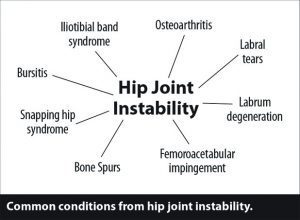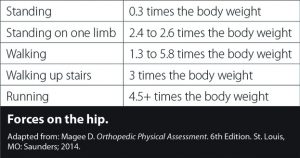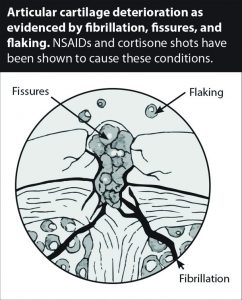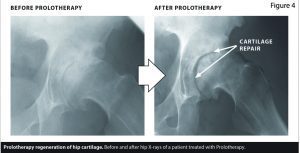By Debra K. Brinker, RN
The popularity of regenerative, non-surgical treatments for painful hip conditions and osteoarthritis has grown in recent years, and with good reason. People want options that are less invasive, do not require anesthesia or a hospital stay, and that give successful long-term results. Being diagnosed with a labral tear or osteoarthritis no longer has to mean giving up leisure activities and signing up for joint replacement surgery. Regenerative options can regrow cartilage and restore degenerated tissue, so that decreased mobility and chronic hip pain become a thing of the past.
Hip instability and labral tears


The hip is a ball-and-socket joint with massive ligaments. Because of this, the hip has been known as a very stable joint, and previously considered to be a joint with infrequent injuries. Over the last decade, hip injuries due to joint instability have become increasingly recognized as a source of pain and disability. (See figure 1.) The hips undergo high rates of wear and tear, attributable to normal use of the hip, which can involve moving the hips at least one million times per year during activities of daily living alone. For athletes, the excessive force placed on the hips for balance and to propel the body during sports imposes and even greater need for hip joint stability. (See figure 2.) Hip instability, due to ligament laxity, is associated with an array of painful conditions including labral tears, ligament degeneration (ligamentosis), and osteoarthritis.


The hip labrum is a ring of cartilage that serves as a cushion and shock absorber to protect the hip and thigh bones. Damage or degeneration to the labrum causes joint instability and pain. Labral tears can be caused by a sudden, specific injury or with overuse. Symptoms include varying degrees of pain, including pain deep in the groin, as well as a clicking, popping, and a locking sensation in the hip joint. These symptoms also indicate that the surrounding ligaments are weak and lax. However, ligament weakness and laxity does not show up on most commonly used diagnostic scans, such as MRI. Because many doctors rely too heavily on MRI and do not perform physical exams for joint instability, the underlying problem is often missed.
Progression to Hip Osteoarthritis
Trace the process of osteoarthritis all the way back to the beginning. It is not just a disease of aging. An original injury occurred at some point to the soft tissue (ligaments, tendons, labrum, or other articular surfaces) whether through athletics, trauma, or “wear and tear.” This injury resulted in weakness of the soft tissue and instability of the joint. The disrupted balance in motion that occurs from the original injury causes an uneven weight distribution inside the joint, with joint surfaces rubbing abnormally and breaking down articular cartilage. This begins to limit joint function, cause bone loss and, eventually, bony overgrowth.
The overgrowth of bone characteristic of osteoarthritis occurs in an attempt to stabilize the unstable hip joint. Thus, the long term consequence of ligament injury, labral tears, and hip instability is osteoarthritis.
Pain Relief and Function Restoration with Prolotherapy


Regenerative Medicine aims to address the original soft tissue weakness, restore the normal biomechanical function of the labrum and stimulate repair where degeneration has occurred. The labrum has a poor blood supply, which makes a tear or injury difficult to treat with conservative approaches. Standard therapeutic approaches (pain medications, corticosteroid injections and arthroscopy) employed to address labral injuries and osteoarthritis, have often been ineffective, because they do not repair the underlying cause of the problem, the injured ligaments, labrum and hip instability. Instead, they accelerate the degenerative process. (See figure 3.) While physical therapy, another popular treatment, can help the surrounding muscles, it does not promote repair to the ligaments or labrum directly. Remember, the problem is not a muscle problem—it is a ligament problem.
Prolotherapy and Stem Cell therapy are regenerative, non-surgical modalities that initiate the restoration of the degenerated ligaments and labrum, thereby improving joint stability and function, as well as reducing pain and symptoms.


Degenerative conditions, such as hip labral injuries and osteoarthritis need regeneration. Regenerative injection treatments repair the labrum and support a pro-chondrogenic (cartilage forming) environment. Prolotherapy involves the injections of natural substances into the degenerated areas to stimulate healing. This regenerative therapy has been found effective for the treatment of la bra I injuries, and has a long history of use in osteoarthritis. (See figure 4.)
Cellular solutions used in Prolotherapy involve the injection of an autologous preparation, from a person’s own plasma, fat or bone marrow. This is injected directly into and around the damaged joint structures. It is a successful non-surgical option that comprehensively addresses hip damage and instability due to labral tears and hip arthritis.
Regenerative Medicine Specialists
CaringMedical.com
239-303-4546
with locations in Fort Myers and Chicagoland
 Southwest Florida's Health and Wellness Magazine Health and Wellness Articles
Southwest Florida's Health and Wellness Magazine Health and Wellness Articles

